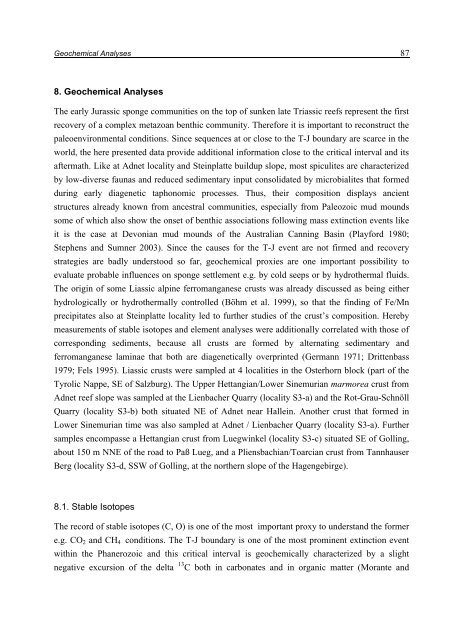Porifera-microbialites of the Lower Liassic (Northern Calcareous ...
Porifera-microbialites of the Lower Liassic (Northern Calcareous ...
Porifera-microbialites of the Lower Liassic (Northern Calcareous ...
You also want an ePaper? Increase the reach of your titles
YUMPU automatically turns print PDFs into web optimized ePapers that Google loves.
Geochemical Analyses 87<br />
8. Geochemical Analyses<br />
The early Jurassic sponge communities on <strong>the</strong> top <strong>of</strong> sunken late Triassic reefs represent <strong>the</strong> first<br />
recovery <strong>of</strong> a complex metazoan benthic community. Therefore it is important to reconstruct <strong>the</strong><br />
paleoenvironmental conditions. Since sequences at or close to <strong>the</strong> T-J boundary are scarce in <strong>the</strong><br />
world, <strong>the</strong> here presented data provide additional information close to <strong>the</strong> critical interval and its<br />
aftermath. Like at Adnet locality and Steinplatte buildup slope, most spiculites are characterized<br />
by low-diverse faunas and reduced sedimentary input consolidated by <strong>microbialites</strong> that formed<br />
during early diagenetic taphonomic processes. Thus, <strong>the</strong>ir composition displays ancient<br />
structures already known from ancestral communities, especially from Paleozoic mud mounds<br />
some <strong>of</strong> which also show <strong>the</strong> onset <strong>of</strong> benthic associations following mass extinction events like<br />
it is <strong>the</strong> case at Devonian mud mounds <strong>of</strong> <strong>the</strong> Australian Canning Basin (Playford 1980;<br />
Stephens and Sumner 2003). Since <strong>the</strong> causes for <strong>the</strong> T-J event are not firmed and recovery<br />
strategies are badly understood so far, geochemical proxies are one important possibility to<br />
evaluate probable influences on sponge settlement e.g. by cold seeps or by hydro<strong>the</strong>rmal fluids.<br />
The origin <strong>of</strong> some <strong>Liassic</strong> alpine ferromanganese crusts was already discussed as being ei<strong>the</strong>r<br />
hydrologically or hydro<strong>the</strong>rmally controlled (Böhm et al. 1999), so that <strong>the</strong> finding <strong>of</strong> Fe/Mn<br />
precipitates also at Steinplatte locality led to fur<strong>the</strong>r studies <strong>of</strong> <strong>the</strong> crust’s composition. Hereby<br />
measurements <strong>of</strong> stable isotopes and element analyses were additionally correlated with those <strong>of</strong><br />
corresponding sediments, because all crusts are formed by alternating sedimentary and<br />
ferromanganese laminae that both are diagenetically overprinted (Germann 1971; Drittenbass<br />
1979; Fels 1995). <strong>Liassic</strong> crusts were sampled at 4 localities in <strong>the</strong> Osterhorn block (part <strong>of</strong> <strong>the</strong><br />
Tyrolic Nappe, SE <strong>of</strong> Salzburg). The Upper Hettangian/<strong>Lower</strong> Sinemurian marmorea crust from<br />
Adnet reef slope was sampled at <strong>the</strong> Lienbacher Quarry (locality S3-a) and <strong>the</strong> Rot-Grau-Schnöll<br />
Quarry (locality S3-b) both situated NE <strong>of</strong> Adnet near Hallein. Ano<strong>the</strong>r crust that formed in<br />
<strong>Lower</strong> Sinemurian time was also sampled at Adnet / Lienbacher Quarry (locality S3-a). Fur<strong>the</strong>r<br />
samples encompasse a Hettangian crust from Luegwinkel (locality S3-c) situated SE <strong>of</strong> Golling,<br />
about 150 m NNE <strong>of</strong> <strong>the</strong> road to Paß Lueg, and a Pliensbachian/Toarcian crust from Tannhauser<br />
Berg (locality S3-d, SSW <strong>of</strong> Golling, at <strong>the</strong> nor<strong>the</strong>rn slope <strong>of</strong> <strong>the</strong> Hagengebirge).<br />
8.1. Stable Isotopes<br />
The record <strong>of</strong> stable isotopes (C, O) is one <strong>of</strong> <strong>the</strong> most important proxy to understand <strong>the</strong> former<br />
e.g. CO2 and CH4 conditions. The T-J boundary is one <strong>of</strong> <strong>the</strong> most prominent extinction event<br />
within <strong>the</strong> Phanerozoic and this critical interval is geochemically characterized by a slight<br />
negative excursion <strong>of</strong> <strong>the</strong> delta 13 C both in carbonates and in organic matter (Morante and

















